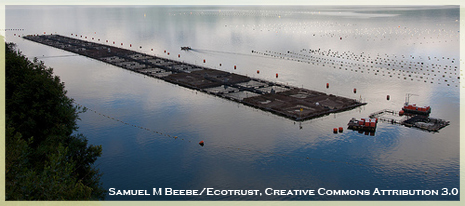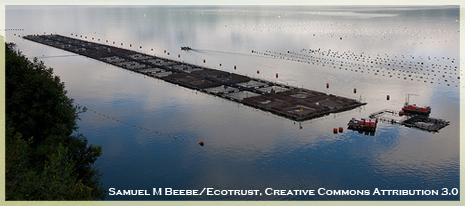
I wish I could remember the exact quote and context, but I was intrigued by the sheer denial of a salmon farmer’s claim that the aquacultured fish were not endangering wild stocks. I guess the preservation of the business drives the denunciation but there has been many peer-reviewed publications over the years presenting evidence that indeed wild fish are threatened by ocean-based cages and farms. That documentary ‘Jean-Michel Cousteau Ocean Adventures: Call of the Killer Whale’, aired in late April and I wish I had used the DVR since I have referenced that show a number of times throughout the last few months. Thus, I welcome any exact quotes from the show to ensure I do it and interviewees justice.
But the documentary is just a springboard into the real nuts and bolts of the fish farming issue that definitely has a marketable appeal to businessmen and everyday people concerned about overfishing alike. Unfortunately the aquaculture solution has unintentional consequences including a decline in wild fish populations, perhaps to near extinction, in areas with high concentrations of fish farms.
According to Neil Frazer, Sea-Cage Aquaculture, Sea Lice, and Declines of Wild Fish, “The difference is that sea cages protect farm fish from the usual pathogen-control mechanisms of nature, such as predators, but not from the pathogens themselves. A sea cage thus becomes an unintended pathogen factory.”
As you can expect, by keeping fish such as salmon in cages with regular feedings we are effectively removing natural selection and enabling week and parasitized individuals to remain active members of the population by decreasing infection mortality. And that means parasites and other micropredators are not culled or kept in control but are free to reproduce and spread.
Sea lice are one of these threats that are capitalizing on this new niche that allows them to persist and thrive. The sea lice are not discriminate in choosing only farmed individuals, but are just as happy to invade wild salmon stock that pass in close proximity to sea cages bubbling with copepodids (Postnaupliar developmental stages of copepods). Instead of a naturally occurring equilibrium of sea lice, wild salmon, and chance encounters, we are establishing a reservoir by which sea lice can survive year around in regions that would otherwise be absent of host salmon because of migration. Thus, sea lice are now available to infect wild juvenile salmon migrating out to sea, which brings about increased juvenile mortality because of their lower body mass. Less juvenile salmon equates to a smaller adult population and a lower number of adults returning to their natal rivers and streams.
So what must be done to ensure wild salmon stocks are again free of human-induced declines? Well, Frazer presents two scenarios:
“Declines of wild fish can be reduced by short growing cycles for farm fish, medicating farm fish, and keeping farm stocking levels low.”
“Declines can be avoided only by ensuring that wild fish do not share water with farmed fish, either by locating sea cages very far from wild fish or through the use of closed-containment aquaculture systems.”
The answer is fairly simple and if sea lice was not an incredible problem the salmon farmers would not be spending 20% of revenue on the issue nor facing $100 million in losses (Frazer, 2009).
Reference:![]()
FRAZER, L. (2009). Sea-Cage Aquaculture, Sea Lice, and Declines of Wild Fish Conservation Biology, 23 (3), 599-607 DOI: 10.1111/j.1523-1739.2008.01128.x


[…] […]